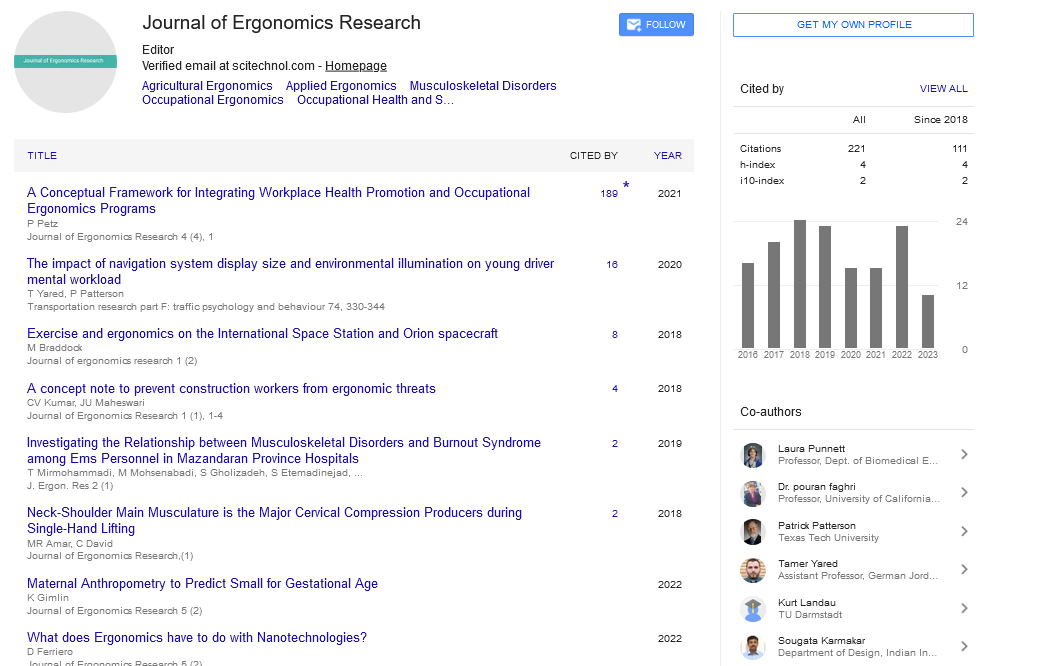Commentary, J Ergon Res Vol: 6 Issue: 4
Kinesiology: Human Movement and Physical Activity
Emerson Nicholas*
1Department of Kinesiology and Community Health, University of Illinois Urbana- Champaign, Urbana, United States of America
*Corresponding Author: Emerson Nicholas,
Department of Kinesiology and
Community Health, University of Illinois Urbana-Champaign, Urbana,
United States of America
E-mail: nicholas.e@gmail.com
Received date: 21 November, 2023, Manuscript No. JEOR-23-123999;
Editor assigned date: 23 November, 2023, PreQC No. JEOR-23-123999 (PQ);
Reviewed date: 07 December, 2023, QC No. JEOR-23-123999;
Revised date: 15 December, 2023, Manuscript No. JEOR-23-123999 (R);
Published date: 25 December, 2023, DOI: 10.4172/JEOR.1000148.
Citation: Nicholas E (2023) Kinesiology: Human Movement and Physical Activity. J Ergon Res 6:4.
Description
Kinesiology, derived from the Greek words "kinesis" (movement) and "logia" (study), it is a multidisciplinary field that explores the science of human movement and physical activity. As an encompassing discipline, kinesiology integrates elements of anatomy, physiology, biomechanics, psychology, and sociology to understand how the body moves and responds to various forms of exercise and activity. With applications in sports, rehabilitation, fitness, and overall health, kinesiology plays an important role in enhancing human performance and well-being.
Historical evolution
Ancient roots: The foundations of kinesiology can be traced back to ancient civilizations, where physical activity and exercise were integral to daily life.
Modern development: In the 20th century, kinesiology evolved into a formal academic discipline, determining from diverse scientific fields to comprehensively study human movement.
Anatomy and physiology
Musculoskeletal understanding: Kinesiology delves into the anatomy and physiology of the musculoskeletal system, examining how bones, muscles, and joints work together during movement.
Energy systems: Understanding physiological responses, such as energy production and cardiovascular adaptations, it is essential for optimizing physical performance.
Sports science
Performance enhancement: Kinesiology is fundamental to sports science, contributing to the optimization of athletic performance through biomechanical analysis, conditioning programs, and injury prevention strategies.
Rehabilitation: In sports medicine, kinesiologists play an essential role in designing rehabilitation programs to help athletes recover from injuries and regain optimal function.
Exercise hysiology
Health and fitness: Kinesiologists apply exercise physiology principles to design fitness programs that promote health and well-being.
Chronic disease management: Exercise interventions informed by kinesiology contribute to managing chronic conditions such as cardiovascular diseases, diabetes, and obesity.
Biomechanics
Movement analysis: Kinesiology employs biomechanics to analyze and optimize human movement patterns, exploring factors such as force, torque, and joint angles.
Injury prevention: Understanding biomechanics helps in designing equipment, footwear, and training techniques to reduce the risk of injuries in sports and physical activities.
Psychology of movement
Motivation and behavior: Kinesiologists delve into the psychological aspects of movement, examining factors that influence motivation, adherence to exercise programs, and the psychological benefits of physical activity.
Sports psychology: In sports settings, kinesiologists collaborate with sports psychologists to enhance athletes' mental resilience and performance.
Motor control and learning
Motor skills: Kinesiology explores the acquisition and refinement of motor skills, studying how individuals learn and control movements.
Skill acquisition: Understanding motor control and learning is essential for coaches, educators, and therapists working to improve individuals' proficiency in various activities.
Exercise prescription
Individualized programs: Kinesiologists develop exercise prescriptions tailored to individual needs, considering factors such as fitness levels, health status, and specific goals.
Periodization: A structuring exercise program over time (periodization) is a important concept in kinesiology, optimizing training for different phases, such as strength, endurance, and recovery.
Sociocultural influences
Social context: Kinesiology acknowledges the sociocultural influences on physical activity, including cultural norms, social support, and societal expectations.
Inclusivity: Considering diverse sociocultural factors is essential for promoting inclusivity and ensuring that physical activity recommendations are culturally sensitive.
Environmental physiology
Impact of environment: Kinesiology examines how environmental factors, such as temperature, altitude, and humidity, affect human performance during physical activities.
Adaptation strategies: Understanding environmental physiology guides the development of techniques to adapt to varying conditions, particularly in outdoor sports and activities.
 Spanish
Spanish  Chinese
Chinese  Russian
Russian  German
German  French
French  Japanese
Japanese  Portuguese
Portuguese  Hindi
Hindi 